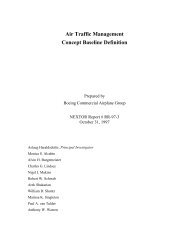Flight SWA 1455 Case Study Workbook - Center for Air ...
Flight SWA 1455 Case Study Workbook - Center for Air ...
Flight SWA 1455 Case Study Workbook - Center for Air ...
- No tags were found...
You also want an ePaper? Increase the reach of your titles
YUMPU automatically turns print PDFs into web optimized ePapers that Google loves.
SUMMARYOn March 5, 2000, about 1811 Pacific standard time (PST),1 Southwest <strong>Air</strong>lines,Inc., flight <strong>1455</strong>, a Boeing 737-300 (737), N668SW, overran the departure end ofrunway 8 after landing at Burbank-Glendale-Pasadena <strong>Air</strong>port (BUR), Burbank,Cali<strong>for</strong>nia. The airplane touched down at approximately 182 knots, and about 20seconds later, at approximately 32 knots, collided with a metal blast fence and anairport perimeter wall. The airplane came to rest on a city street near a gasstation off of the airport property. Of the 142 persons on board, 2 passengerssustained serious injuries; 41 passengers and the captain sustained minorinjuries; and 94 passengers, 3 flight attendants, and the first officer sustained noinjuries.PROBABLE CAUSEThe National Transportation Safety Board determines that the probable cause ofthis accident was the flight crew’s excessive airspeed and flightpath angle duringthe approach and landing and its failure to abort the approach when stabilizedapproach criteria were not met. Contributing to the accident was the controller’spositioning of the airplane in such a manner as to leave no safe options <strong>for</strong> theflight crew other than a go-around maneuver.SIGNIFICANT EVENTS1. Changing surface wind conditions at the destination required the crew tochange their arrival plan2. <strong>Air</strong> Traffic Control caused the flight to be both fast and high whenbeginning the approach3. Captain attempted to descend to runway without using maximum ef<strong>for</strong>ts toslow4. Despite the excessive airspeed pilots continued with their plan to land(and NOT execute a go-around)5. captain delayed application of maximum breaking6. Shortest runway7. Runway closest to public area8. No EMAS systemCopyright Lance Sherry 20092
















